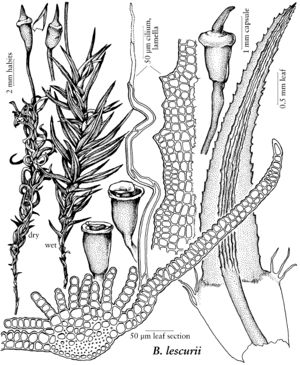Bartramiopsis
Rev. Bryol. 21: 33. 1894 ,.
| Taxon | Illustrator ⠉ | |
|---|---|---|
 | Bartramiopsis lescurii | Patricia M. Eckel |
Plants slender, not distinctly polytrichoid. Stems simple. Leaves with a sheathing base and divergent limb; sheath ciliate on the shoulders, not hyaline-margined; limb serrate-toothed to the sheath (or ciliate near the base), with lamellae restricted to the adaxial surface of the costa; lamina 2-stratose, with sporadic 1-stratose patches, the adaxial layer of cells bulging-mammillose; lamellae serrate in profile, the marginal cells in section not differentiated, smooth. Capsule short-cylindric, terete, flaring at the mouth when old and empty, weakly contracted at the base, the long-tapering neck merging with the seta; exothecial cells without thin spots or pits; stomata present, confined to the neck; operculum conic; peristome none; columella flaring at the tip, persisting and elevated above the rim of the capsule. Calyptra naked. Spores papillose.
Distribution
Northern Pacific Radiant distribution, nw North America, e Asia (Japan), e Asia (e Siberia)
Discussion
Species 1.
Diagnostic features of Bartramiopsis include the serrate lamellae, the ciliate sheath, the terete capsule, which is flared at the mouth and tapers toward the base, the absence of a peristome, and the naked calyptra. The genus occupies an isolated position in the family, and the gametophyte has a curious un-polytrichoid appearance. The bistratose lamina and the absence of even a rudimentary peristome have led to its association with Lyellia, but the capsule in that genus is strongly dorsiventral with 2 sharp angles, with a bowl-shaped disc at the capsule mouth and the blunted columella apex forming a “stopper” in the small central opening. In Bartramiopsis, the exserted columella is broadly flared, extends to the capsule rim, and persists long after the operculum is shed.
Selected References
None.
Lower Taxa
"broadened" is not a number.